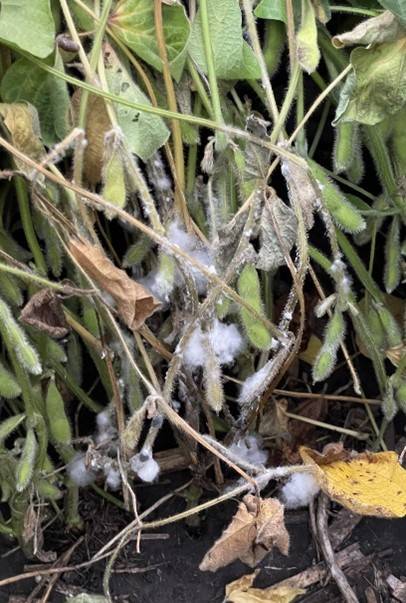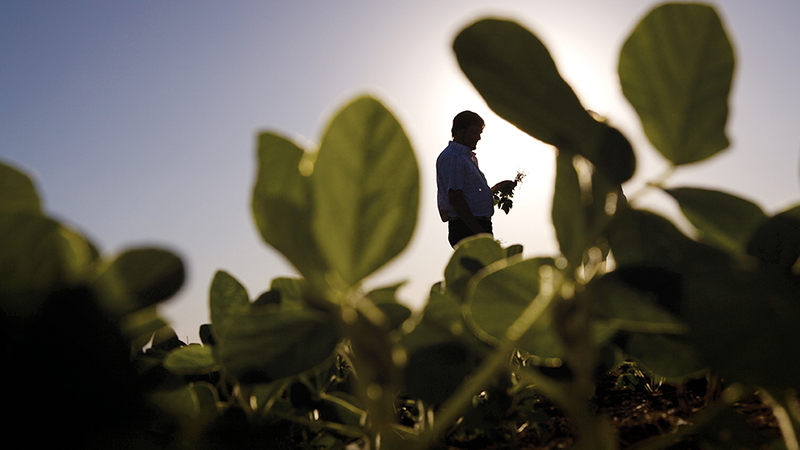How Short Lane Ag Partnered With a Soybean Grower to Test Seed Treatments for White Mold
Within close proximity to the Great Lakes, National Forests, and America’s best cheese and dairy producers, Northern Wisconsin is a wonderful place to live and farm.
For Short Lane Ag Supply – a CropLife 100 company that operates three ag retail locations in Clark, Manitowoc, and Trempealeau counties – the cool climate, short growing season, high humidity, and heavy, highly fertile soils bring along another concern when working with soybean growers: the high likelihood of losing yield to Sclerotinia White Mold.
This concern prompted Short Lane Ag Owner Matt Oehmichen to partner with Colin Dutcheshen, President of Heads Up Plant Protectants, to test its longstanding seed treatment Heads Up. Oehmichen then proceeded to find a progressive local farmer who had a field with a notorious history of white mold and was rotating back to soybeans in spring 2023.

Sclerotinia white mold in soybeans.
Dutcheshen, who had already been working with Oehmichen for several years, explains “The idea was to test the seed treatment in more than just a replicated small plot situation. Working with Short Lane Ag Supply, I knew the challenges their customers face and that Matt would be a perfect partner to conduct a broad acre, real world situation test with a local grower. The idea was to put the seed treatment to the test in an area where white mold had a strong likelihood of showing up, but also to help Matt collect relatable, localized data on our product which would be relevant to the customers he serves.”
The Field Trial
Conducted in replicated strip plots, Oehmichen contacted a Clark County grower who had a 38-acre parcel of land which met all the criteria. The grower would be planting soybeans and had a field with a particularly lousy history of white mold, which meant a high likelihood of the disease redeveloping. Sclerotinia White Mold, a fungal disease that plagues soybean acres across the Midwest, overwinters in survival bodies called sclerotia, and these sclerotia could be found in the grower’s soils.
Treating the seed for the grower, Oehmichen allocated 40 units of soybeans to receive a base seed treatment, inoculant, and Heads Up, and 40 units with the base seed treatment and inoculant only.
The grower split the planter and layout of the field by mapping replicated strips across the 38 acres. He managed the field after planting just as he would any other field. All things considered, the only variable that changed across the site was that Heads Up was used on every other strip he planted.
In Season
While the 2023 growing season turned out to be a dry year (not favorable for white mold development, a disease which thrives in cool and wet conditions), Oehmichen noticed differences. “The Heads Up treated beans in our trial just had a ‘deeper, greener vibrance’ to them,” Oehmichen explains. “I attribute the color differences to reduced stress.”
He also noticed the soybeans didn’t seem to turn yellow as early as the check and had more pod sets and more lateral branching.
The Results
Results across the 38-acre parcel show the strips with Heads Up yielded an average of four bushels better than the check strips. Per strip yield differences were measured between +2.73 to +5.1 bu/ac better with the Heads Up seed treatment package than the check alone.
Returning an average of four bushels an acre better than the base seed treatment package, Heads Up made for a solid return on investment. Oehmichen explains, “It only takes 1/3 of a bushel to pay for the treatment. With today’s soybean prices (around $12/bushel) every bushel after that first 1/3 of a bushel is pure profit. And its no extra work for the farm.”








